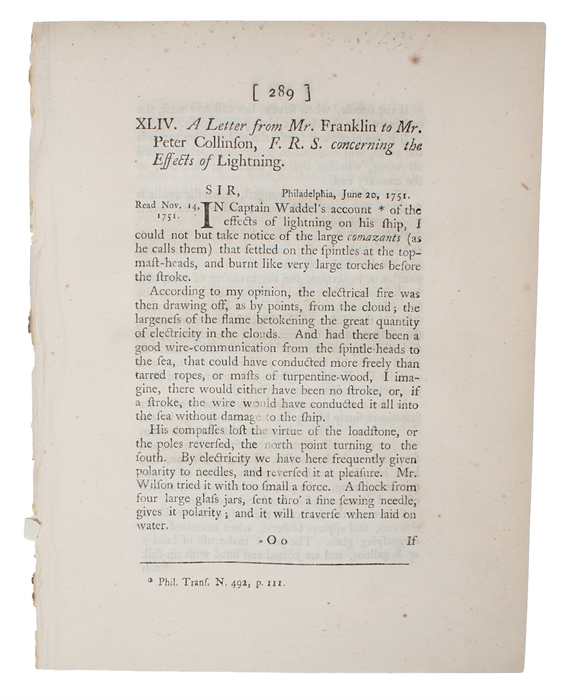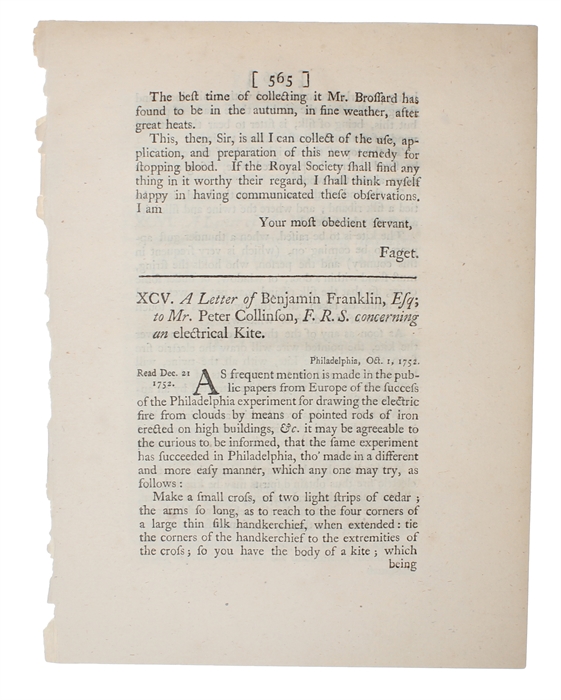THE KITE-LETTER - RECORDING THE MOST FAMOUS ELECTRICAL EXPERIMENT
FRANKLIN, BENJAMIN.
A Letter from Mr. Franklin to Mr. Peter Collinson, F.R.S. concerning the Effects of Lightening. Philadelphia, June 20, 1751. Read Nov. 14, 1751. (+) A Letter of Benjamin Franklin, Esq: to Mr. Peter Collinson, F.R.S. concerning an electrical Kite. Philadelphia, Oct. 1, 1752. Read Dec. 21, 1752. (2 Papers).
London, C. Davis, 1753.
4to. Without wrappers. Extracted from "Philosophical Transactions", vol. 47. Including title-page of volume. Title-page with repair to inner margin. Pp. 289-91; pp. 565-70.
First appearance of both papers, one of them being the milestone paper in which Franklin describes his lightning experiment and proves what he had already conjectured, that lightening is an electrical discharge. Both of the present papers were to become part of his famous work "Experiments and Observations on Electricity.." assembled by his friend Peter Collinson, to whom the papers were addressed. The famous letter was also published in the "Gentleman's Magazine" for 1752.
"Franklin was the first American scientist to achieve an international reputation, with his work on electricity... The most dramatic result of Franklin's researches was the proof that lightening is really an electrical phenomenon. Others had made such a suggestion before him - even Newton himself - but it was he who provided the experimental proof. In 1752 he flew a kite in a thunderstorm and attached a key to its string. From this he collected electrical charges in a Leiden jar and showed that atmospheric and frictional or machine-made electricity are the same. He went on to propose the fixing of iron rods at the top of buildings, masts of ships, etc., from which he conducted the electric charges they collected from lightening into the wet subsoil - the invention of the lightening conductor.
"His reputation as a scientist was immediately established by the publication of the results of his researches in a series of letters addressed to Peter Collinson, a London merchant and naturalist, in 1751; and the Experiments and Observations [ which collected all the Collinson letters not just those offered here ] remains the most important scientific book of eighteenth-century America." (PMM 199).
"Later, Franklin devised a second experiment to test the electrification of clouds (the first was the sentry-box experiment), one which has become more popularly known: the lightning kite. Franklin reported his experiments to Collison in a letter of October 1752 (the paper offered), written after Franklin had read "in the public papers from Europe, of the success of the Philadelphia -Experiment for drawing the electric fire from clouds by means of pointed rods of iron erected on high buildings..." Actually, Franklin appears to have flown his electrical kite prior to having learned of Dalibard's successful execution of the sentry-box experiment. The KITE LETTER, published in the "Philosophical Transactions", referred to the erection of lighetning rods on public buildings in Philadelphia. The lightening experiment caused Franklin's name to become known throughout Europe to the public at large and not merely to men of science. Joseph Priestly, in his "History...of Electricity", characterized the experimental discovery that the lightening discharge is an electrical phenomenon as "THE GREATEST, PERHAPS, SINCE THE TIME OF NEWTON".....the discoveries made in the summer of 1752 will make it memorable in the history of electricity," William Watson wrote in 1753. "These have opened a new field to philosophers, and have given them room to hope, that what they have learned before in their museums, they may apply, with more propriety than they have hitherto could have done, in illustrating the nature and effects of thunder; a phenomenon hitherto almost inaccessible to their inquiries."(DSB V, pp. 134-35).
The volume offered contains a series of other notable papers: T. Simpson (mathematics), Thomas Debenham (medicine), James Parsons (Phocae Marinae, the long-necked seal), W. Watson (the sex of flowers), Francis Blake (steem-engine), William Watson (An Account of Mr. Benjamin Franklin's Treatise, lately published, Experiments and Observations on Electricity..."pp. 202-211),Dunthorne (on comets), William Watson ("An Account of the Phaenomena of Electricity in vacuo", pp. 362-376), J. Smeaton (Air-pump), Richard Brooke (surgery), Abbe Nollet (electricity from the clouds), W. Watson (electrical experiments in England upon Thunder-Clouds), etc. etc.
Order-nr.: 54545



